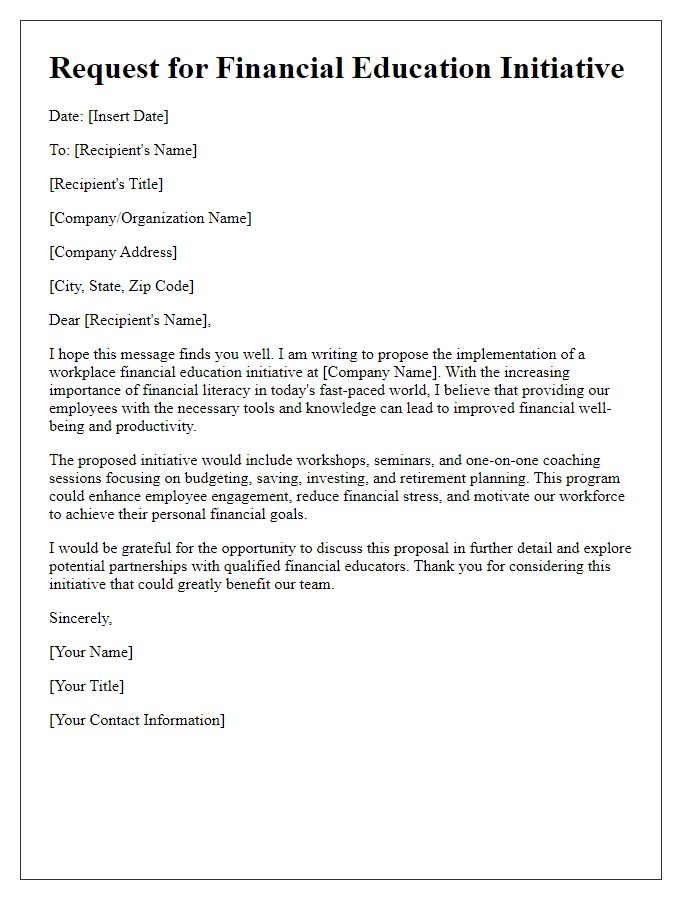Are you looking to elevate your organization's commitment to employee well-being? Introducing a financial wellness program could be the key to fostering a healthier workforce and enhancing overall productivity. By providing your team with the necessary tools and resources to manage their financial health, you'll empower them to thrive both personally and professionally. Dive into this proposal to discover how implementing a financial wellness program can benefit your organization's culture â read on!

Program Goals and Objectives
The financial wellness program aims to enhance the financial literacy of participants (individuals aged 18-65) by providing educational resources and personalized coaching. Key objectives include reducing high-interest debt, such as credit card balances (average American household debt of approximately $15,000), increasing emergency savings to cover at least three months of expenses, and fostering investment habits with the goal of building a diverse portfolio of assets (stocks, bonds, real estate). Workshops will be held monthly in community centers across various locations (with an initial rollout in underserved urban areas), providing access to expert speakers and interactive sessions. Additionally, participants will receive access to online tools for budgeting and tracking expenses, aiming for a 75% improvement in financial confidence measured through pre- and post-program surveys.
Target Audience and Demographics
The financial wellness program aims to assist individuals facing varying degrees of financial challenges, particularly focusing on demographics such as employees within large corporations, college students navigating tuition debt, and single parents managing tight budgets. The target audience primarily includes working professionals aged 25-45, many of whom are experiencing financial stress due to rising living costs, student loan repayment demands exceeding $1.7 trillion in the United States, and childcare expenses averaging $200-1,500 monthly. Additionally, surveys reveal that 62% of millennials are living paycheck to paycheck, signifying a pressing need for effective financial education. This program will also cater to those from diverse socio-economic backgrounds, ensuring inclusivity and access to financial literacy resources that empower participants to build savings, manage debt, and achieve long-term financial goals.
Key Features and Benefits
A financial wellness program can significantly enhance employees' understanding of personal finance management, encompassing budgeting, saving, and investment strategies. Key features may include interactive workshops led by certified financial planners, focusing on retirement planning and debt management, fostering a culture of financial literacy. Online resources, such as calculators and budgeting tools, provide continuous access to helpful materials for employees. Regular webinars, addressing topics like tax optimization and insurance choices, empower participants to make informed decisions. Benefits extend to increased employee engagement and productivity, coupled with reduced financial stress leading to improved overall well-being, thus benefiting the organization by fostering a more focused and motivated workforce. Additionally, providing personalized consultations can cater to individual financial needs, ensuring tailored support for diverse financial situations.
Implementation Plan and Timeline
Proposed implementation of a financial wellness program includes a comprehensive timeline to ensure successful launch and engagement. Phase one consists of program design, including needs assessment (Survey of employee financial literacy) and material creation (workshops, online resources, and personalized budgeting tools), scheduled for January to March 2024. Phase two involves pilot testing, allowing a select group of employees to access and provide feedback on materials and workshops, taking place in April 2024. Following adjustments, phase three will include comprehensive rollout across the organization, commencing in May 2024, with ongoing support (monthly webinars, one-on-one consultations) and resources available throughout the program duration. Evaluation metrics, including participant satisfaction and financial behavior changes, will be collected quarterly to assess program effectiveness, ensuring continuous improvement and relevance.
Metrics for Success and Evaluation
A financial wellness program, aimed at enhancing the financial literacy of employees, requires clear metrics for success and robust evaluation methods. Key performance indicators (KPIs) such as participation rate, measured as a percentage of total employees, can provide initial insights into engagement levels. Financial knowledge assessments, conducted pre- and post-program, can quantify improvements in understanding fundamental financial concepts, such as budgeting or retirement savings, often represented by a scoring system on a scale from 0 to 100. Monitoring changes in employees' financial behaviors, such as increased contributions to retirement accounts like 401(k)s, can indicate program effectiveness. Additionally, tracking reductions in employee stress levels related to finances, using survey tools with specific numerical scales, can highlight improvements in overall wellbeing. Regular feedback through structured evaluations every six months can ensure the program remains aligned with employee needs, offering leadership a comprehensive overview of its impact on workplace morale and productivity.













Comments